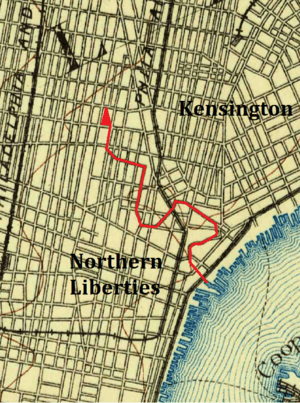Cohocksink Creek facts for kids
The Cohocksink Creek was once a stream in Philadelphia. It flowed between the areas now known as Northern Liberties and Kensington. This creek was a smaller river that flowed into the Delaware River. Its name comes from the Lenape people, meaning "pine lands." Some people also called it Stacey's Creek. The creek started from two smaller streams joining together near what is now Sixth and Thompson Streets. It's sometimes confused with another buried stream, Cohoquinoque Creek, which is nearby.
Early Philadelphia and the Creek
The Cohocksink Creek and its marshlands acted like a natural border. They separated the District of Kensington from the main city of Philadelphia and its Northern Liberties area.
The first European settlers here were Swedish, even before William Penn founded the colony of Pennsylvania. By the 1700s, people used the creek's water power for their businesses. Mills and tanneries (places that make leather) were built along its banks. William Penn himself had a mill built near the creek.
The neighborhoods around the Cohocksink Creek became important centers for early industries in Philadelphia. During the American Revolution, the British army used the creek as a defense line when they occupied Philadelphia. They placed artillery (large guns) on the south side. They also dammed the stream to create a wide marshy area. This made it harder for attacks to come from the north.
Why the Creek Disappeared
By the mid-1700s, factories in the area started using other power sources, so they didn't rely on the creek as much. The neighborhoods were growing, and people wanted better drainage. Also, there was a belief called the miasma theory, which suggested that bad smells from the creek caused sickness.
So, in the 1850s, the Cohocksink Creek was turned into a storm sewer. This happened around the time Northern Liberties and Kensington became part of the city of Philadelphia. The creek had become very polluted by this point. Factories, homes, and streets had dumped waste into it.
The City Board of Health said that turning the creek into a sewer was a very important health improvement. They described the creek as a source of "unpleasant odors" and a place where "waste" collected. This pollution was believed to cause diseases in the area.
The Creek Today
After the creek was buried, it sometimes overflowed during heavy rainstorms. But over time, it has been better contained. Today, many people don't even know that a former creek runs beneath their streets. The Cohocksink now flows underground, following the path shown on old maps.


